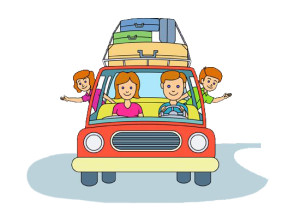Doctors’ Notes
BackTraveling With Children, Part I (Overview & Infants)
How can you plan a trip that will be fun and relaxing for the entire family, rather than fodder for a bad TV sitcom? I’ve enjoyed traveling with my family over the years, and have learned — sometimes the hard way — some things that work well and some things that don’t.
Whether it’s a car trip to Grandma’s house or a big adventure trip, a bit of planning goes a long way. For kids of any age, start by thinking about what things you enjoy doing together as a family. What activities would be a fun change of pace to stretch minds & bodies, and what would just be too hard or too boring for your kids with their current abilities or interests? What venues could offer something enjoyable for everyone?

Include kids in the planning, and remember that wet kids are usually happy kids — the hotel must have a pool! Plan down times for naps if your kids still take them, and don’t forget to bring car seats — and, for warm-weather trips, bike helmets and plenty of sunscreen. (For more on sunscreen, see Dr. Hartung’s excellent note on the subject.)
Finally, don’t forget the camera — your kids may hate you taking lots of pictures now, but you’ll all enjoy looking at them for years to come.
Now that I’ve given you a brief overview for all ages, I’ll follow up — in this note, and in two more to follow — with suggestions for specific age groups. We’ll start today with…
Traveling With Infants
Traveling with infants can be a challenge, although most parents will tell you it’s easier than traveling with toddlers! If you’re traveling by car, make sure, of course, that your child is buckled in to her car seat while the vehicle is moving. Plan frequent stops to feed the baby, and break up long trips with an overnight stay somewhere.
If you’ll be flying, consider postponing the trip until after your child has had her first set of shots, for some protection against the serious germs at crowded planes and gate areas. (They’re typically given at the 2-month visit, but can be given as early as 6 weeks of age.)
Many airlines will allow a child under 2 to ride on a parent’s lap, and will try to book your seat next to an empty seat. If that seat remains empty — a rarity these days! — you can place your child’s car seat in that seat for the flight. It’s more expensive, but obviously safer, to purchase a seat for your infant. You can buckle your child’s car seat into the airplane seat, and she can ride just as she’s used to in the car.
Strollers used to get your child onto the plane, as well as car seats that did not find an empty seat next to yours, can be “gate checked,” and will be brought to the exit ramp for you at your destination. If you plan ahead, a parent traveling alone with an infant or young child can get a ride on the airport assistance carts, making getting from gate to gate with stroller, car seat, diaper bag, and baby in tow so much easier! Ask about this when scheduling your flights. Rental car agencies generally will not guarantee car seat availability, so it’s best (unfortunately) to take your own.
As we all know, pressure changes can create discomfort in our ears, especially when descending. Adults chew gum or pull on our ears to “pop” them, opening up the Eustachian tubes to equalize the pressure. Infants can achieve the same effect by sucking on a pacifier, bottle, or breast (although they should be back in those car seats for landing preparation). Some acetaminophen about 30 –45 minutes before landing can help as well.
Traveling with an infant can be exhausting, but if you visit grandparents this year, then it’s their turn to come to you next year, when traveling gets to be even more exciting!
For more on this subject at other ages, see:
Part 2: Traveling with Toddlers & Preschoolers
Part 3: Traveling with School-Aged Children and Teens
Dr. Sarah Springer, a Kids Plus Doc, serves as the Medical Director of Adoption Health Services of Western Pennsylvania.